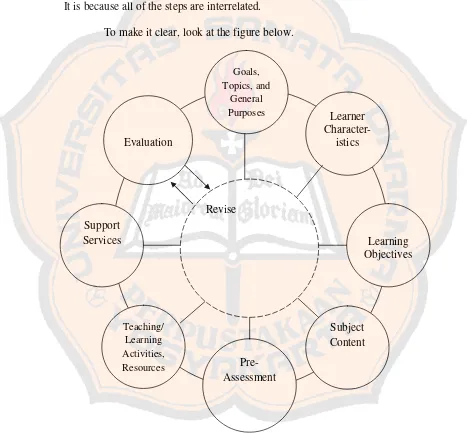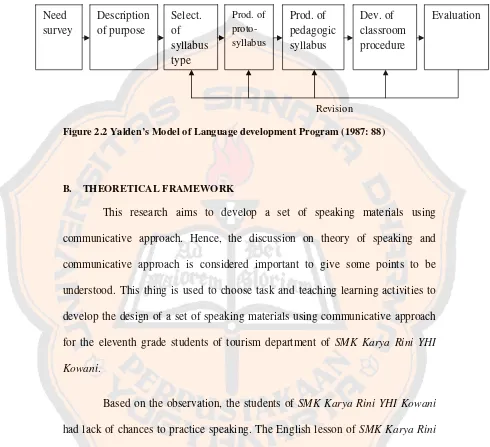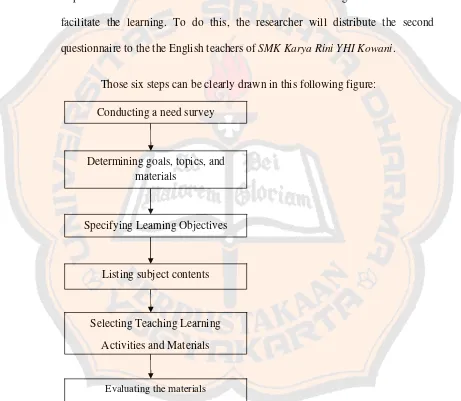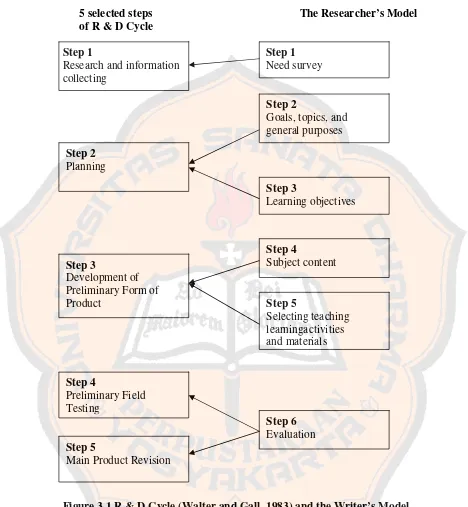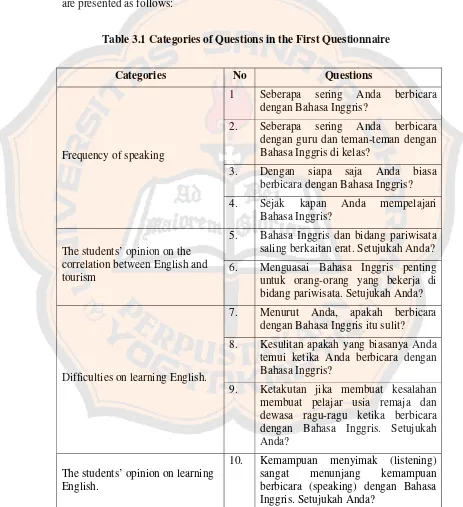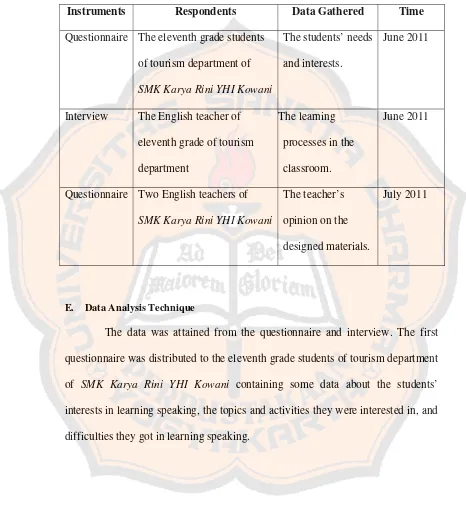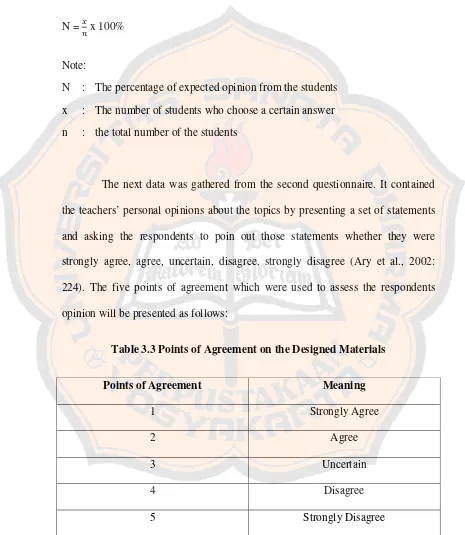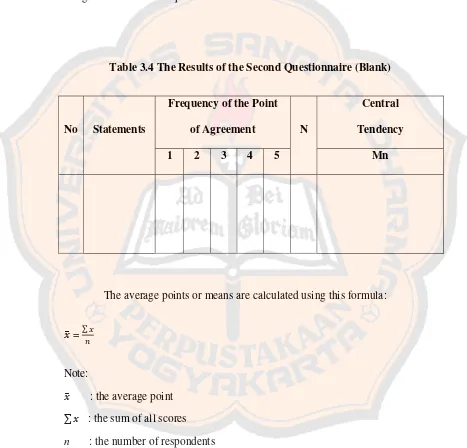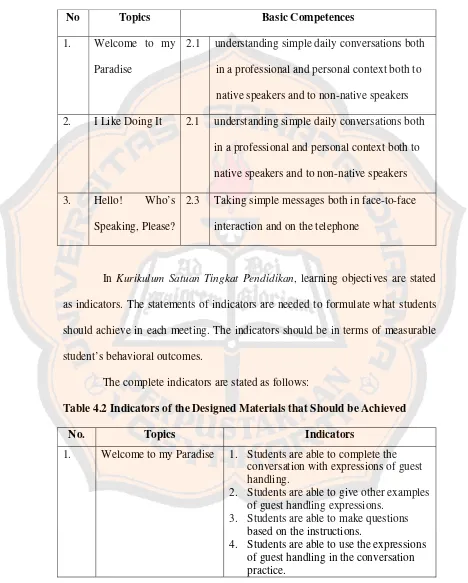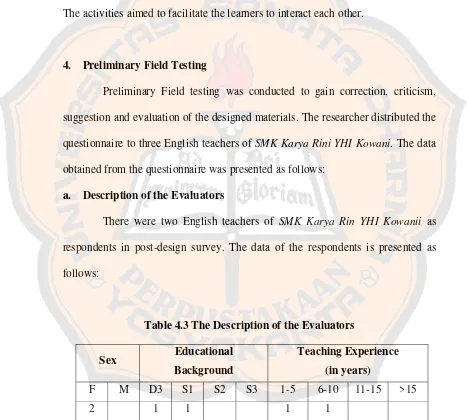A SET OF SPEAKING MATERIALS USING COMMUNICATIVE APPROACH FOR THE ELEVENTH GRADE STUDENTS
OF TOURISM DEPARTMENT OFSMK KARYA RINI YHI KOWANI
A THESIS
Presented as Partial Fulfillment of the Requirements to Obtain the Sarjana Pendidikan Degree
in English Language Education
By
Agnes Aline Wulandari
Students Number: 041214096
ENGLISH LANGUAGE EDUCATION STUDY PROGRAM DEPARTMENT OF LANGUAGE AND ARTS EDUCATION FACULTY OF TEACHERS TRAINING AND EDUCATION
SANATA DHARMA UNIVERSITY YOGYAKARTA
i
A SET OF SPEAKING MATERIALS USING COMMUNICATIVE APPROACH FOR THE ELEVENTH GRADE STUDENTS
OF TOURISM DEPARTMENT OFSMK KARYA RINI YHI KOWANI
A THESIS
Presented as Partial Fulfillment of the Requirements to Obtain the Sarjana Pendidikan Degree
in English Language Education
By
Agnes Aline Wulandari
Students Number: 041214096
ENGLISH LANGUAGE EDUCATION STUDY PROGRAM DEPARTMENT OF LANGUAGE AND ARTS EDUCATION FACULTY OF TEACHERS TRAINING AND EDUCATION
SANATA DHARMA UNIVERSITY YOGYAKARTA
ii
iii
iv
DEDICATION PAGE
I dedicated this thesis to:
Dr. Retno Muljani, M.Pd.
Audifax Niko Kris Pratama
v
STATEMENT OF WORK’S ORIGINALITY
I honestly declare that this thesis, which I have written, does not contain the work or parts of the work of other people, except those cited in the quotations and the references, as a scientific paper should.
Yogyakarta, July 29, 2011
The Writer
Agnes Aline Wulandari
vi
LEMBAR PERNYATAAN PERSETUJUAN
PUBLIKASI KARYA ILMIAH UNTUK KEPENTINGAN AKADEMIS
Yang bertanda tangan di bawah ini, saya mahasiswa Universitas Sanata Dharma:
Nama : Agnes Aline Wulandari
Nomor Mahasiswa : 041214096
Demi pengembangan ilmu pengetahuan, saya memberikan kepada Perpustakaan
Universitas Sanata Dharma karya ilmiah saya yang berjudul:
A SET OF SPEAKING MATERIALS USING COMMUNICATIVE
APPROACH FOR THE ELEVENTH GRADE STUDENTS OF
TOURISM DEPARTMENT OF SMK KARYA RINI YHI KOWANI
beserta perangkat yang diperlukan (bila ada). Dengan demikian saya memberikan
kepada Perpustakaan Universitas Sanata Dharma hak untuk menyimpan,
mengalihkan dalam bentuk media lain, mengelolanya dalam bentuk pangkalan
data, mendistribusikan secara terbatas, dan mempublikasikannya in internet atau
media lain untuk kepentingan akademis tanpa perlu meminta ijin dari saya maupin
memberikan royalti kepada saya selama tetap mencantumkan nama saya sebagai
penulis.
Demikian pernyataan ini yang saya buat dengan sebenarnya.
Dibuat di Yogyakarta
Pada tanggal 29 Juli 2011
Yang menyatakan
vii
ABSTRACT
Wulandari, Agnes Aline. 2011. A Set of Speaking Materials Using Communicative Approach for the Eleventh Grade Students of Tourism Department of SMK Karya Rini YHI Kowani.Yogyakarta: English Language Education Study Program, Sanata Dharma University.
Speaking skill is really important for the students of tourism department since people working on tourism field need to communicate orally. From the observation, it was found that the students of SMK Karya Rini YHI Kowani have difficulties in expressing something orally. Having minimal contact with native speakers, the students need something authentic which can present the real atmosphere of communication of the target language. Communicative approach can be an alternative to solve that problem because this approach employs authentic materials and focuses on interaction in the classromm.
This research aimed to design a set of speaking materials using communicative approach for the eleventh grade students of tourism department of
SMK Karya Rini YHI Kowani. This research dealt with two problem formulation: (1) How is a set of speaking materials using communicative approach for the eleventh grade students of tourism department of SMK Karya Rini YHI Kowani is designed? and (2) What does a set of speaking materials for the eleventh grade students of tourism department of SMK Karya Rini YHI Kowani look like?
To answer the first question, the researcher adapted Kemp’s and Yalden’s Instructional Design Model and R & D (Research and Development) method. There were five steps applied in the research: (1) Research and Information Collecting, (2) Planning, (3) Develop Preliminary Form of Product, (4) Preliminary Field Testing, (5) Main Product Revision.
To answer the second question, the researcher presented the final version of the designed materials after the revision. The materials consist of three units: (1) Welcome to my Paradise, (2) I Like Doing It, and (3) Hello, Who’s Speaking, Please? Each unit is divided into three sections: (1) Pre-Task Activity, (2) Task Cycle, and (3) Language Focus.
Based on the results of the evaluation, the materials are suitable and acceptable.The result of the descriptive statistics showed that the grand mean was more than 4 (four).
Hopefully, these designed materials will be useful to improve the students’ speaking ability and will encourage other researchers to develop other materials.
viii
ABSTRAK
Wulandari, Agnes Aline. 2011. A Set of Speaking Materials Using Communicative Approach for the Eleventh Grade Students of Tourism Department of SMK Karya Rini YHI Kowani. Yogyakarta: Program Studi Pendidikan Bahasa Inggris, Universitas Sanata Dharma.
Kemampuan berbicara sangat penting untuk siswa jurusan pariwisata karena orang-orang yang bekerja di bidang pariwisata perlu untuk berkomunikasi secara lisan. Dari pengamatan, diketahui bahwa siswa jurusan pariwisata SMK Karya Rini YHI Kowani memiliki kesulitan untuk mengungkapkan sesuatu secara lisan. Karena rendahnya kontak dengan penutur asli, siswa memerlukan sesuatu yang otentik yang mampu menghadirkan suasana nyata dari komunikasi pada bahasa target. Pendekatan komunikatif dapat menjadi sebuah pilihan untuk mengatasi masalah tersebut karena pendekatan ini menggunakan materi otentik dan fokus pada interaksi di ruang kelas.
Penelitian ini bertujuan untuk merancang seperangkat materi berbicara menggunakan pendekatan komunikatif untuk siswa kelas XI jurusan pariwisata
SMK Karya Rini YHI Kowani. Penelitian ini mengemukakan dua rumusan masalah: (1) Bagaimana seperangkat materi berbicara menggunakan pendekatan komunikatid dirancang untuk siswa kelas XI jurusan pariwisata SMK Karya Rini YHI Kowani? dan (2) Bagaimana bentuk seperangkat materi berbicara untuk siswa kelas XI jurusan pariwisata SMK Karya Rini YHI Kowani?
Untuk menjawab pertanyaan pertama, peneliti mengadaptasi model rancangan Kemp dan Yalden dan metode R & D (penelitian dan pengembangan). Ada 5 tahap dalam penelitian ini: (1) Penelitian dan Pengumpulan Informasi, (2) Perencanaan, (3) Pengembangan Bentuk Awal Produk, (4) Pengujian Awal di Lapangan, (5) Perbaikan Produk Utama.
Untuk menjawab pertanyaan kedua, peneliti menyajikan hasil akhir dari materi setelah perbaikan. Materi terdiri dari tiga unit: (1) Welcome to my Paradise, (2) I Like Doing It, dan (3) Hello! Who’s Speaking, Please? Setiap unit dibagi menjadi tiga bagian: (1) Pre-Task Activity, (2) Task Cycle, dan (3) Language Focus.
Berdasarkan hasil evaluasi, materi ini sesuai dan dapat diterima. Hasil statistik deskriptif menunjukkan bahwa nilai total rata-rata lebih dari 4 (empat).
Semoga materi ini bermanfaat untuk memperbaiki kemampuan berbicara siswa dan mampu mendorong penelitian lain untuk mengembangkan materi lain.
ix
ACKNOWLEDGEMENTS
I praise Jesus Christ for giving me this miracle. Only because of His blessing, finally I can complete this thesis. Nothing is impossible for Jesus.
My deepest gratitude to my sponsor, Dr. Retno Muljani, M.Pd. Thank you for encouraging me in accomplishing this work. I am nothing without her
guidance. Special appreciation also goes to all lecturers of English Language
Education Study Program for teaching and sharing many things during my study
in Sanata Dharma University.
With all my love, I give thanks to Audifax Niko Kris Pratama. Thank you for loving and always being around whenever I need help. His support is
everything to me. I dedicate this thesis for him.
I should thank all teachers and staff ofSMK Karya Rini YHI Kowani for making the process so easy, especially ibu Ani Alifah, S.Pd. I thank her for guiding me in developing the materials for the students of SMK Karya Rini YHI
Kowani.
For my parents, Daniel Sarjio and Paulina Agustina, this thesis is for them, too. For my nephew,Ivano Wasesadewa, my brother,Petrus Dhoni Wisnugroho, and my sister-in-law,Anggela Ratnasari,I thank them for always supporting and praying for me.
x
Their support encourage me to finish my study. I am also very grateful to my
business partner, Uning Yuniati and her brothers for giving great support.
Finally, my gratitude also goes to those who have given me a hand,
whom I cannot mention one by one. May God bless them.
xi
TABLE OF CONTENTS
Page
TITLE PAGE ... i
APPROVAL PAGES ... ii
DEDICATION PAGE ... iv
STATEMENT OF WORK’S ORIGINALITY ... v
LEMBAR PERNYATAAN PERSETUJUAN PUBLIKASI ... vi
ABSTRACT ... vii
ABSTRAK ... viii
ACKNOWLEDGMENTS ... ix
TABLE OF CONTENTS ... xi
LIST OF TABLES ... xvi
LIST OF FIGURES ... xvii
LIST OF APPENDICES ... xviii
CHAPTER I: INTRODUCTION ... 1
A. Background of the Study... 1
B. Problem Formulation ... 5
C. Problem Limitation ... 6
D. Research Objective ... 6
E. Research Benefits ... 7
xii
1. Instructional Materials ... 8
2. Speaking ... 8
3. Communicative Approach ... 9
4. The Eleventh Grade Students of Tourism Department of SMK Karya Rini YHI Kowani ... 9
CHAPTER II: THEORETICAL REVIEW... 11
A. Theoretical Description ... 11
1. Speaking Skill ... 11
a. Age or Maturational Constraints ... 12
b. Aural Medium ... 12
c. Sociocultural Factors ... 13
d. Affective Factors ... 13
a) Acting from a Script ... 14
b) Communication Games ... 14
c) Discussion ... 14
d) Prepared Talks ... 15
e) Questionnaires ... 15
f) Simulation and Role-Play ... 15
(a) Grammatical Competence ... 16
(b) Discourse Competence ... 16
(c) Sociolinguistic Competence ... 17
xiii
2. Communicative Approach ... 17
3. Designing Instructional Materials ... 19
a. Kemp’s Instructional Materials Design Model ... 20
b. Yalden’s Instructional Materials Design Model ... 22
1) Stage 1: The Need Survey ... 22
2) Stage 2: Description of the Purpose ... 22
3) Stage 3: Selection or Development of Syllabus Type ... 22
4) Stage 4: The Proto-Syllabus ... 22
5) Stage 5: The Pedagogical Syllabus ... 23
6) Stage 6: Development and Implementation of Clasroom Procedures ... 23
7) Stage 7: Evaluation ... 23
8) Stage 8: Recycling ... 23
B. Theoretical Framework ... 24
1. Conducting a Need Survey ... 25
2. Determining Goals, Topics and General Purposes ... 26
3. Specifying Learning Objectives ... 26
4. Listing Subject Contents ... 26
5. Selecting Teaching Learning Activities and Materials ... 26
xiv
CHAPTER III: METHODOLOGY ... 28
A. Research Method ... 28
B. Research Participants ... 31
1. Respondents of the Pre-Design Survey ... 31
2. Respondents of the Post-Design Survey ... 32
C. Research Instruments ... 33
1. Questionnaire ... 33
2. Interview ... 36
D. Data Gathering Technique ... 36
E. Data Analysis Technique ... 37
F. Research Procedures ... 40
CHAPTER IV: RESEARCH FINDINGS AND DISCUSSION ... 41
A. Research Findings ... 41
1. Research and Information Collecting ... 41
a. The Result of the Questionnaire Distributed to the Eleventh Grade Students ... 41
b. The Result of the Interview with the English Teacher 45 2. Planning ... 47
3. Develop Preliminary Form of Product ... 49
a. Pre-Task Activities ... 49
b. Task Cycle ... 50
xv
4. Preliminary Field Testing ... 51
a. Description of the Evaluators ... 51
b. Data Presentation and Analysis ... 52
5. Main Product Revision ... 55
B. Discussion on the Designed Materials ... 56
CHAPTER V: CONCLUSION AND SUGGESTIONS A. Conclusion ... 61
B. Suggestions ... 62
xvi
LIST OF TABLES
Table Page
3.1 Categories of Questions in the First Questionnaire ... 34
3.2 The Whole Process of Data Collecting ... 37
3.3 Points of Agreement on the Designed Materials ... 38
3.4 The Results of the Second Questionnaire ... 39
4.1 Basic Competences of Designed Materials ... 48
4.2 Indicators of the Designed Materials ... 48
4.3 The Description of the Evaluator ... 51
4.4 The Descriptive Statistics of the Evaluators’ Opinion ... 52
4.5 Product Specification ... 56
xvii
LIST OF FIGURES
Figure Page
2.1 Kemp’s Model ... 21
2.2 Yalden’s Model ... 24
2.3 The Researcher’s Framework ... 27
xviii
LIST OF APPENDICES
Appendices Page
Appendices A
Permission Letter from Sanata Dharma University ... 68
Permission Letter from Bappeda ... 69
Information Letter from SMK Karya Rini YHI Kowani ... 72
Appendices B Questionnaire on Research and Information Collecting ... 73
Interview Guideline ... 76
Questionnaire Result ... 77
Interview Result ... 80
Appendices C Questonnaire on Preliminary Field testing ... 83
Questionnaire Result ... 85
General Description ... 86
Appendices D Syllabus ... 90
Lesson Plan ... 99
1
CHAPTER I INTRODUCTION
A. Background of the Study
In this globalization era, the world needs a universal language that unifies
many people from many different countries in communication. Crystal (1997: 2)
says that a language achieves its global status when it develops a ‘special role
which is recognized in every country’.This special status can be achievedif a
language becomes an official language of the country or if the country gives
special priority to the language by requiring its study as a foreign language.
English meets that requirement.
McKay (2002: 17) mentions that 90% of international bodies in Asia and
the Pacific and many international scientific organizations carry on their
proceedings only in English. Hence, he concludes that as an international
language in a global sense, English is the key which enables countries to discuss
and negotiate political, social, educational, and economic concerns.
That is why nowadays almost all companies in many countries including
companies in Indonesia propose a specific requirement of English ability, orally in
particular, on their vacancy letters. Even in the beginning of the job application,
job applicants sometimes have to do an oral test in English in their interview
process. The aim is no other than to seek employees who are able to make
is why learning English can be a necessity to anybody before entering the working
world.
In order to make students accustomed to this international language,
teachers of any school levels have been teaching English as early as possible.
Language materials used are improved and adjusted to curriculum and learning
purposes. Teachers of senior high schools have a greater duty and responsibility to
enhance their students’ English skill; preparing them to continue to a higher
educational level – college – before finally entering the gate of working world.
Then teachers of vocational schools have to prepare their students to face the
working world right after their graduation. In Kurikulum SMK Edisi 2004 (2004: 1) Departemen Pendidikan Nasional saysthat as a part of national educational system, vocational schools focus on the development of the students’ abilities to
work in certain fields, to adapt to the working environment, to catch working
opportunities, and to develop themselves in the future. That is why teachers of the
vocational schools have to push themselves to be more active, creative and
innovative in the learning process so that their students will get more interest into
the subject and eventually improve their language skills.
Tourism department is one of the departments held by vocational
schools. Pusat Pengembangan Penataran Guru Kejuruan Bisnis & Pariwisata
says in Materi Sosialisasi Kurikulum SMK 2004 Mata Diklat Bahasa Inggris that based on Undang-undang Sistem Pendidikan Nasional, the general objective of vocational school is to prepare the students to work in certain fields. It also stated
enrich the students with skills, knowledge and manner to do the duty in Front
Office area as receptionists, reservation staff, telephone operators and Porters or
the duty in Housekeeping are as Public Area Attendants, Room Attendants, Order
Takers, Linen and Uniform Attendants and also Laundry Attendants.
Tourism and English influence and are related each other. McKay in her
book Teaching English as an International Language Rethinking Goals and Approaches (2002: 18) mentions that travel and tourism fuel the current spread of English. As cited by McKay, Graddol (1997) points out that over 10 per cent of
the world’s labor is employed in tourist-related industries and notes international
travel has a globalizing effect, promoting the need for a common language; that is
English. She adds that international airports around the world have essential
information available in English and major international hotels have
English-speaking staff available. It is not surprising if employees working in tourism field
are required to master English actively. Staff working on the tourism field should
be able to master English not only to have conversation but also to explain or
describe something to the guests.
Unfortunately, the researcher’s experience when teaching three eleventh
grade students of SMK Karya Rini YHI (Yayasan Hari Ibu) Kowani in an English course showed that the students there had lack of chances to practice speaking.
The researcher found that they needed much time to express their opinion or
thought on certain topics. They even had difficulty in choosing appropriate
vocabulary to produce sentences orally. That is why their speaking ability was
An approach is needed to teach speaking based on the needs of the
eleventh grade students of tourism department. Richards (2002: 204) states that
speaking a language is especially difficult for foreign language learners because
effective oral communication requires the ability to use the language appropriately
in social interactions. He adds that owing to minimal exposure to the target
language and contact with native speakers, adult learners of English as Foreign
Language in general are relatively poor at spoken English, especially regarding
fluency, control of idiomatic expressions, and understanding of cultural
pragmatics. These statements direct the researcher to choose an approach that
requires the learners to interact each other during the lesson with authentic
materials as the teaching aid to present the real atmosphere of communication in
the classroom.
Nunan (1991: 51) says that learning to speak in a second or foreign
language will be facilitated when learners are actively engaged in attempting to
communicate. Nunan (2003: 50) then adds that several studies led to the
conclusion that people don’t learn the pieces of the language and then put them
together to make conversations but infants acquire their first language and people
acquire second languages by interacting with other people. It is suitable with the
concept of communicative language teaching or often called communicative
approach: if people learn by interacting, then learners should interact during the
lessons.
To replicate communication in real life, activities in communicative
69). Richards and Rodgers (2001: 170) state that many proponents of
communicative language teaching make use of authentic materials in the
classroom. They also mention that learning activities are selected according how
well they engage the learner in meaningful and authentic language use than
merely mechanical pratice of language patterns. They add that pair and group
work is suggested to encourage students to use and practice functions and forms.
With respect to this, the writer offers a set of speaking materials using
communicative approach to be applied in a selected vocational school, that is,
SMK Karya RiniYHI Kowani, specifically to teach the eleventh grade students of tourism department. The writer chooses the students of tourism department as the
subject of the study because the graduatesare predicted to potentially meet, face
and communicate with much more people with various foreign citizens and
background languages due to their job in tourism field.
B. Problem Formulation
From the explanation above, the writer formulates this study into two
main questions, they are:
1. How is a set of speaking materials using communicative approach designed
for the eleventh grade students of tourism department of SMK Karya Rini YHI Kowani?
2. What does a set of the speaking materials using communicative approach for
C. Problem Limitation
The problems to discuss in this study are limited to designing a set of
speaking materials based on communicative approach for the students of grade XI
of tourism department of SMK Karya Rini YHI Kowani. This research intends to help the students to enhance their speaking ability.
The speaking materials using communicative approach are designed for
the eleventh grade students of tourism department of SMK Karya Rini YHI Kowani based on Kurikulum Tingkat Satuan Pendidikan 2006 and adjusted to the students’ needs and interests. By learning from authentic materials, they will adapt
to speak like in a real communication and by talking about something they like
and they are interested in, they are expected to practice speaking enthusiastically.
D. Research Objective
In line with the problem formulation, the objective of the study is to
designa set of speaking materialsbased on communicative approach for the
E. Research Benefits
This research is intended to give some benefits to all parties dealing with
the English learning in SMK Karya Rini YHI Kowani. The significances, therefore, will be clarified as follows:
1. for the Eleventh Grade Studentsof Tourism Department of SMK Karya Rini YHI Kowani
The eleventh grade students of tourism department of SMK Karya Rini YHI Kowani will get a set of speaking materials based on the result of the research. The speaking materials provide chances to practice speaking in a
challenging and enjoyable way to improve their speaking skills.
2. for the English Teachers of SMK Karya Rini YHI Kowani
The English teachers of SMK Karya Rini YHI Kowani can use the speaking materials based on communicative approach for the eleventh grade students
of tourism department of SMK Karya Rini YHI Kowani as sources to teach.
3. for the Researcher
The researcher, as a student of English Education Study Program, will get
many experiences and much knowledge in designing a set of speaking
materials based on communicative approach for the students of grade XI of
tourism department of SMK Karya Rini YHI Kowani.
4. for Future Researches
The result of this research can be a starting point to conduct other researches
about English for Senior High School or Vocational School because the
F. Definition of Terms
To clarify concepts and avoid misinterpretation, here the writer defines
the terms used in this study:
1. Instructional Materials
Richard and Rodgers (2001: 29) define that instructional materials can
provide detailed specifications of content, even in the absence of syllabus. They
give guidance to teachers on both the intensity of coverage and the amount of
attention demanded by particular contents of pedagogical tasks. In this research,
similar to Richard and Rodgers, instructional materials focus on the discussion
and all things which are going to be taught and learned.
2. Speaking
Speaking is the productive skill in the oral
mode(http://www.sil.org/lingualinks/languagelearning/otherresources/gudlnsfraln
ggandcltrlrnngprgrm/SpeakingSkill.htm). Nunan (1991: 51) says that the theory
and research summarised in the preceding section suggest that learning to speak in
a second or foreign language will be facilitated when learners are actively
engaged in attempting to communicate. He also cites what Swain suggests: we
learn to read by reading, so also do we learn to speak by speaking. In this
research, the teachers give the students many speaking activities to enhance their
speaking ability.
Richards (2002: 208) says that communication in the classroom is
instruction carefully to the needs of learners and teach them how to listen to other,
how to talk with others, and how to negotiate meaning in a shared context.
In this research, speaking activities means all teaching learning activities
that facilitate students to practice producing oral languange.
3. Communicative Approach
Communicative approach is also often called communicative language
teaching . Richards and Rodgers (2001: 155) say that for some, communicative
language teaching means little more than an integration of grammatical and
functional teaching. As they cite, Littewood states that one of the most
characteristic features of communicative language teaching is that it pays
systematic attention to functional as well as structural aspects of language.
Richards and Rodgers (2001: 169) state that a variety of games, role
plays, simulations, and task-based communication activities have been prepared to
support communicative language teaching. They add that many proponents of
communicative language teaching have advocated the use of authentic, “from life”
materials in the classroom.
In this research, the writer proposes the use of authentic materials and
activities that present the real communication in the speaking classrom.
4. The Eleventh Grade Students of Tourism Department of SMK Karya Rini YHI Kowani
Bisnis & Pariwisata says in Materi Sosialisasi Kurikulum SMK 2004 Mata Diklat Bahasa Inggris that they are prepared to work in tourist-related industries such as hotels as public area attendants, room attendants, order takers, linen and uniform
attendants and also laundry attendants, etc.
Eleventh grade is perceived as the second year in vocational school to
learn the theoretical subjects including English. They will focus on the National
Examination on the third year of the study and do the practical subjects related to
tourism field in the fourth year of their study.
The writer finds some interesting basic competences in Kurikulum Tingkat Satuan Pendidikan 2006 which can be used to develop some topics of the designed speaking materials based on communicative approach for the eleventh
grade students of tourism department of SMK Karya Rini YHI Kowani.
11
CHAPTER II
THEORETICAL REVIEW
This chapter mainly discusses the review of related literature to support the
research. There are two parts of discussion. The first part is Theoretical
Description consists of brief discussion on some theories as the basis of the study.
The theories are discussed to establish the framework of the study. The second
part is Theoretical Framework that summarizes all the major relevant theories for
designing the materials.
A. Theoretical Description
There are three topics to discuss in this section. They are Speaking Skill,
Communicative Approach, and Designing Instructional Materials. Therefore, this
section is divided into three parts. Each part reviews the theories of the topics
mentioned previously.
1. Speaking Skill
Richards (2002: 204) states that speaking a language is especially
difficult for foreign language learners because effective oral communication
requires the ability to use the language appropriately in social interactions.
Learning to speak a foreign language requires knowing not only its grammatical
and semantic rules but also how native speakers use the language in the context of
structured interpersonal exchange. Therefore, Richards adds that it is difficult for
language fluently and appropriately. Here are some factors affecting adult English
as Foreign Language learners’ oral communication according to Richards (2002:
205):
a. Age or Maturational Constraints
As Richards cites, Krashen, Long, and Scarcella (1982) argue that
acquirers who begin learning a second language in early childhood through
natural exposure achieve higher proficiency than those beginning as adults.
Richards also add that Oyama’s study (1976) shows that many adults fail to reach
nativelike proficiency in a second language. This phenomenon is called
fossilization, the permanent cessation of second language develepoment. This
shows that the aging process itself may affect or limit adult learners’ ability to
pronounce the target langauge fluently with nativelike pronunciation (Scarcella &
Oxford, 1992).
b. Aural Medium
Richards says that listening plays an extremeliy important role in the
development of speaking abilities. Speaking feeds on listening, which precedes it.
He cites Mendelson & Rubin (1995: 35) “While listening, learners must
comprehend the text by retaining information in memory, integrate it with what
follows, and continually adjust their understanding of what they hear in the light
of prior knowledge and of incoming information.“ If one cannot understand what
c. Sociocultural Factors
To speak a language, one must konw how the language is used in a social
context. It is well known that each langauge has its own rules of usage as to when,
how, and to what degree a speaker may impose a given verbal behavior on his
conversational partner (Berns, 1990). Because of the influence or interference of
their own cultural norms, it is hard for nonnative speakers to choose the forms
appropriate to certain situations.
d. Affective Factors
The affective factors related to foreign language learning are emotions,
self-esteem, empathy anxiety, attitude and motivation. Richards cites Brown
(1994) mentions that foreign language learning is a complex task that is
susceptible to human anxiety, which is associated with feelings of uneasiness,
frustration, self-doubt and apprehension. Unlike children, adults are concerned
with how they are judged by others. Richards concludes that the sensitivity of
adult learners to making mistakes, or fear of “losing face”, has been the
explanation for their inability to speak English without hesitation.
Knowing those factors, Richards (2002: 208) states that a key factor in
foreign language development is the opportunity given to learners to speak in the
language-promoting interaction. Nunan (1991: 51) also says that the theory and
research summarised in the preceding section suggest that learning to speak in a
second or foreign language will be facilitated when learners are actively engaged
read by reading, so also do we learn to speak by speaking.Therefore, English
teachers should be creative in rising the students’ willingness to speak or at least
in giving them reason to speak in English. They can teach speaking with either
attractive activities or interesting topics.
Here are some attractive speaking activities which are widely used in
many schools, according to Harmer (2002: 348):
a) Acting from a Script
English teachers can ask their students to act out scenes from plays
and/or their coursebooks. Perhaps students will often act out dialogues they have
written themselves. When students are working on plays, they should perform as
‘real’ acting. English teachers need to help them to go through the scripts as if the
teachers were theatre directors, direct the students in producing appropriate stress,
intonation and speed when they are acting out dialogues or performing the plays.
b) Communication Games
There are some popular games aimed to get students talking as quickly
and fluently as possible. One of them is called guessing game. This game can be
used to make the students practice on describing people, things and animals.
c) Discussion
Teachers can divide the students into some small or big groups then ask
them to give comments on a reading passage they have read before or a statement
about certain topic. Teachers can also ask the students to prepare arguments in
favour or against various topics. To make the debates successful, students need to
d) Prepared Talks
Another popular speaking activity is the prepared talk, where a student
(or a group of students) makes a presentation on a topic. Teachers need to give
them time to prepare their talks and help them in the preparation, if necessary. The
students also need a chance to rehearse their presentations. They can present each
other in pairs or small groups first.
e) Questionnaires
By being planned before, questionnaires ensure both questioner and
respondents have something to say to each other. Students can design
questionnaires on certain topics given. They work in pairs, one becomes a
questioner and the other becomes a respondent. The results obtained can start a
discussion, then.
f) Simulation and Role-Play
Simulation and role-play can encourage the students’ oral fluency in an
interesting way. English teachers should allow them to be as creative as possible,
but they have to get enough information about the situation in the story. By
broadening the world of the classroom to include the world outside, simulation
and role-play help students to use a wider range of language than other
task-centred activities may do.
Richards cites that Hymes (1971) assumes that foreign language learners
need to know not only the linguistic knowledge, but also the culturally acceptable
of communicative competence consists of the interaction of grammatical,
psycholinguistic, sociolinguistic, and probabilistic language components. Being
influenced by Hymes’ theory, Canale and Swain (1980) mentions that
communicative competence includes grammatical competence, discourse
competence, discourse competence, sociolinguistic competence, and strategic
competence, that reflect the linguistic system and the functional aspects of
communication.
(a) Grammatical Competence
As Richards cites, Scarcella & Oxford (1992: 141) says that
“Grammatical competence is an umbrella concept that includes increasing
expertise in grammar (morphology, syntax), vocabulary, and mechanics.” To
convey meaning, foreign language learners should have knowledge of words and
sentences. They have to understand how words are segmented into various sounds
and how sentences are stressed in particular ways. Therefore, grammatical
competence enables speakers to use English accurately and fluently.
(b) Discourse Competence
Richards (2002: 207) says that in communication, both the production
and comprehension of a language require one’a ability to perceive and process
stretches of discourse, and to formulate representations of meaning from referents
in both previous sentences and following sentences. Discourse competence
(c) Sociolinguistic Competence
Richards (2002: 207) mentions that learners must have competence
which involves knowing what is expected socially and culturally by users of the
target language. Understanding the socilinguistic aspect of language will help
learners to give appropriate comments or responses.
(d) Strategic Competence
As cited by Richards, Berns (1990) says strategic competence is the
ability to compensate fot imperfect knowledge of linguistic, sociolinguistic, and
discourse rules. It refers to the ability to know how to keep the conversation
going, how to start or take turn or end the conversation and how to clear up
communication breakdown as well as comprehension problems.
2. Communicative Approach
Communicative approach is also often called communicative language teaching.
Richards and Rodgers (2001: 155) says that for some, communicative language teaching
means little more than an integration of grammatical and functional teaching. They cite
Littewood states that one of the most characteristic features of communicative language
teaching is that it pays systematic attention to functional as well as structural aspects of
language. They add that for others, it means using procedures where learners work in
pairs or groups employing available language resources in problem-solving tasks.
Here are some features of communicative approach, according to
Finocchiaro and Brumfit as cited by Richards and Rodgers (2001: 156):
a. Meaning is paramount.
normally memorized.
c. Contextualization is a basic premise.
d. Language learning is learning to communicate.
e. Effective communication is sought.
f. Drilling may occur, but peripherally.
g. Comprehensible pronunciation is sought.
h. Any device that helps the learners is accepted – varying according to their
age, interest, etc.
i. Attempts to communicate may be encouraged from the very beginning.
j. Judicious use of native language is accepted where feasible.
k. Translation may be used where students need or benefit from it.
l. Reading and writing can start from the first day, if desired.
m. The target linguistic system will be learned best through the process of
struggling to communicate.
n. Communicative competence is the desired goal (i.e. the ability to use the
linguistic system effectively and appropriately).
o. Linguistic variation is a central concept in materials and methodology.
p. Sequencing is determined by any consideration of content, function, or
meaning that maintains interest.
q. Teachers help learners in any way that motivates them to work with the
language.
r. Language is created by the individual, often through trial and error.
in the abstract but in context.
t. Students are expected to interact with other people, either in the flesh,
through pair and group work, or in their writings.
u. The teacher cannot know exactly what language the students will use.
v. Intrinsic motivation will spring from an interest in what is being
communicated by the language.
Richards and Rodgers (2001: 161) added some of the characteristics of
communicative view of language:
a) Language is a system for the expression of meaning.
b) The primary function of language is to allow interaction and communication.
c) The structure of language reflects its functional and communicative uses.
d) The primary units of language are not merely its grammatical and structural
features, but categories of functional and communicative meaning as
exemplified in discourse.
3. Designing Instructional Materials
In this section, the writer discusses some basic consideration in making
the instructional material design. The writer discussed Kemps’s instructional
design and Yalden’s instructional material design model.
The writer chooses these two models because they have similar
characteristics in the process of analyzing learning needs, goals, and developing
the system to meet the learners’ needs. The models describe clearly all the detail
order to develop the program from the very beginning step. These models are also
flexible, meaning that the models could be applied to design either the general
English program or an ESP program. Then the writer combined both of them to be
designed model.
a. Kemps’s Instructional Materials Design Model
Kemp (1977) offers eight steps in designing the program development.
The steps are:
1) Considering the goals and list of topics strating the general purpose for
teaching each topic.
2) Enumerating the important characteristics of the learners for whom the
instruction is to be designed.
3) Specifying the learning objectives to be achieved in terms of measurable
students behavioral outcomes.
4) Listing the subject contents to support each objective.
5) Developing pre-assessment to determine the students’ background and
present level of knowledge about the topic.
6) Selecting teaching/learning activities and instructional resource that will treat
the subject content so the students will accomplish the objectives.
7) Coordinating support service such as budget, personnel, facilities, equipment,
and schedule to carry out the instructional plan.
8) Evaluating the learners’ learning in terms of their accomplishment of
objectives with a view to revise and re-evaluate any phases of the plan that
The eight step suggested by Kemp are flexible. This is the strength of
Kemp’s model. There is interdependence among the eight elements; decisions
relating to one may affect other (Kemp, 1977: 9). A designer can start from any
step then move back and forth to the other steps whenever the designer is ready.
It is because all of the steps are interrelated.
To make it clear, look at the figure below.
Figure 2.1 Kemp’s Model (Kemp, 1977: 9)
Learner
Character-istics
Learning Objectives
Pre- Assessment
Teaching/ Learning Activities, Resources
Support Services
Evaluation
Subject Content
Goals, Topics, and
General Purposes
b. Yalden’s Instructional Materials Design Model
Yalden states that in order to understand the process of constructing
instructional design we have to examine the overall process of planning of second
language program. It will be beneficial for the building of well-organized process
of designing the materials. The process of developing a language program covers
seven stages as follows.
1) Stage 1: The Need Survey
This step is conducted to collect the information about the learners’
needs. This stage is paramount to don in order that the production of the purpose
for the program can be realistic and acceptable.
2) Stage 2: Description of the Purposes
Description of the purposes is prepared in term of the characteristics of
the students and the skill the students to entry and on exit from the program. The
formulation of purposes of the of the language will set up the basis of selecting or
developing the type of syllabus.
3) Stage 3: Selection or Development of Syllabus Type
There are a number of syllabus types. However, there is no single syllabus type
design is generally applied in any language program. The combination of various
model can possibly applied.
4) Stage 4: The Proto-Syllabus
At this stage, the syllabus designer describes the content of the syllabus. The
descripiton of language and language function should be included in the rpogram,
variety of language, communicative events, as well as grammar.
5) Stage 5: The Pedagogical Syllabus
The syllabus design contains teaching, learning, and testing as well. It is intended
to provide the teacher with knowledge about the learners, the learners’ purposes of
learning English, and to match this knowledge with suitable content and teaching
techniques.
6) Stage 6: Development and Implementation of Classroom Procedures
In this stage, the teacher has to select the teaching techniques and the type of
exercise. The commuincative syllabus will give implication changes in the
teacher’s roles. The teacher should tend to be a facilitator rather than a leader of
the class. Moreover, the teacher also needs to prepare the lesson plans and
schedules for the program altogether.
7) Stage 7: Evaluation
There are three major aspects to evaluate in this stage, namely the students, the
teaching, and the program as well. The final performance of the students is needed
to be evaluated whether it fits the purposes of the program.
8) Stage 8: Recycling
At this phase, the revision of the materials and teaching approaches is done if
there are discrepancies between the purposes of the program and the students’
Yalden’s instructional design is presented as follows:
Revision
Figure 2.2 Yalden’s Model of Language development Program (1987: 88)
B. THEORETICAL FRAMEWORK
This research aims to develop a set of speaking materials using
communicative approach. Hence, the discussion on theory of speaking and
communicative approach is considered important to give some points to be
understood. This thing is used to choose task and teaching learning activities to
develop the design of a set of speaking materials using communicative approach
for the eleventh grade students of tourism department of SMK Karya Rini YHI Kowani.
Based on the observation, the students of SMK Karya Rini YHI Kowani
had lack of chances to practice speaking. The English lesson of SMK Karya Rini YHI Kowani, especially the speaking skill, needs to be developed into an active learning through some teaching learning activities that allow the students to be the
center of the learning and give the students more chances to interact each other.
Therefore, the researcher introduces an alternative strategy to facilitate the
The researcher chooses communicative approach which facilitates the
students to interact each other in real communication and uses authentic materials
to help the students in replicating the real atmosphere of communication. In
designing the speaking materials using communicative approach for the eleventh
grade students of tourism department of SMK Karya Rini YHI Kowani, the researher adapts and combine both Kemp’s mdel and Yalden’s instructional
design model. The researcher adapts five stages of Kemp’s model, namely
determining goals, topics, and general purposes, specifying the learning
objectives, stating subject contents, and selecting teaching learning activities and
materials and evaluation. The researcher also takes a stage from Yalden’s model
that could not be found in Kemp’s model namely needs survey.
In brief, the reseacher sets six stages from combining and adapting the
two instructional design models. The stages are (1) conducting needs survey, (2)
determining goals, topics and general purposes, (3) specifying learning objectives,
(4) listing subject content, (5) selecting teaching learning activities and materials,
(6) evaluation.
1. Conducting a Need Survey
This is the first step of Yalden’s model as a preliminary step in
developing the speaking materials which suits the students’ needs. At this step, the
researcher collect and gain information about students’ needs, interests, and
difficulties in learning by distributing a questionnaire to the eleventh grade
information about the students’ characteristics supporting the production of the
designed materials can be gathered by interviewing the English teacher.
2. Determining Goals, Topics, and General Purposes
This step is taken from Kemp’s model “Considering goals, list topics,
and stating the general purposes”, the same as Yalden’s model “Description of
Purposes”. The researcher decides the goals as the foundation for developing the
speaking materials using communicative approach for the eleventh grade students
of tourism department of SMK Karya Rini YHI Kowani. After that, the researcher chooses the topics to achieve the goals. The topics will be chosen based on the
result of the need survey. Then the researcher will formulate the general purposes
of each topic.
3. Specifying Learning Objectives
This stage is adapted from Kemp’s model. After considering the
purposes, the researcher will formulate specified objectives of the learning to be
achieved in every meeting.
4. Listing Subject Contents
This stage is taken from Kemp’s model. In this stage, the writer lists the
subject contents to be learnt by the students in order to achieve the objectives.
5. Selecting Teaching Learning Activities and Materials
This step is adapted from Kemp’s model. Enjoyable and interesting
activities should be applied in order to enhance the students’ speaking motivation
also attract the students’ interest and attention. The arrangement of both activities
and materials will be based on the result of the needs survey.
6. Evaluating Materials
The researcher adopts the eighth step of Kemps’ model and the seventh
step of Yalden’s. It is a need to observe whether the designed materials best
facilitate the learning. To do this, the researcher will distribute the second
questionnaire to the the English teachers of SMK Karya Rini YHI Kowani.
Those six steps can be clearly drawn in this following figure:
Figure 2.3 The Researcher’s Framework
Determining goals, topics, and materials
Specifying Learning Objectives
Listing subject contents
Selecting Teaching Learning
Activities and Materials
Evaluating the materials
28
CHAPTER III METHODOLOGY
There are six sections of discussion in this chapter. The discussions are
about research method, research subject and respondents, which describess
method of sampling, research participants, research instruments which describes
kinds of instruments used in the research, data gathering technique, which
describes method and techniques used to collect the empirical data, data analysis,
which describes the ways to analyze the findings so as to answer the research
problems, and research procedures, which describes the illustration of steps in the
research.
A. Research Method
As it has been stated in the problem formulation, this research dealt with a
major problem to be solved. It is to design a set of speaking materials using
communicative approach for the eleventh grade students of tourism department of SMK
Karya Rini YHI Kowani. To solve this problem, the researcher used Education Research
and Development (R&D) method in conducting the research. This method was used to
help the researcher to develop the product based on the finding through the analysis, to
test the materials whether it was relevant to the target situation or not and then to revise it
in order to have most appropriate materials which can facilitate the learners well.
In conducting the study, there were some major steps offered by Walter (1991:
775) in the R&D cycle used to develop mini courses. The first is research and information
collecting. It includes review of literature, classroom observation, and preparation of
objectives and determining courses sequence. After preparing the planning, the next step
is developing preliminary form of the product including preparation of designed
materials, handbooks, and evaluation devices. The next step is about main product
revision. The revision is conducted based on the teachers’ corrections, . After that, the
final revision was the last revision. This step is about revision of product as suggested by
operational field-test results. The last step is about the report of the final product. In order
to make the explanation obvious, the researcher made a diagram of the steps of the
Step 2
Goals, topics, and general purposes
Step 3
Development of Preliminary Form of
Product Step 5
Selecting teaching learningactivities and materials
Step 3
Learning objectives
Step 4
Subject content
Step 2
Planning
Step 4
Preliminary Field Testing
Step 5
Main Product Revision
Step 6
Evaluation
5 selected steps The Researcher’s Model of R & D Cycle
Step 1 Step 1
Research and information Need survey collecting
Figure 3.1 R & D Cycle (Walter and Gall, 1983) and the Writer’s Model
Through the explanation of each step of R&D steps, the researcher found
steps in designing the materials. Furthermore, those steps could support each other
to make the designed materials. It could be concluded that the writers frameswork
and R&D framework matched each other.
B. Research Participants
There were two groups of this survey. The first group was involved in
pre-design survey intended to gain information about the learners’ needs. The
second group was involved in post-design survey intended to gain feedback on the
proposed materials design in order to revise the materials to facilitate the learners’
needs well.
1. Respondents of the Pre-Design Survey
To collect the data for the needs survey, the researcher involved both the
eleventh grade students of tourism department of SMK Karya Rini YHI Kowaniand their English teacher.
a. The Eleventh Grade Students of Tourism Department of SMK Karya Rini YHI
Kowani
The researcher distributed questionnaires to twenty five of eleventh grade
students of tourism department of SMK Karya Rini YHI Kowani. It aimed to know the students’ needs and interests in learning English, especially in speaking skill.
The speaking materials were designed by the researcher based on their needs and
b. The English Teacher of Eleventh Grade of Tourism Department of SMK Karya
Rini YHI Kowani
To complete the needs survey, the researcher also interviewed the
English teacher of eleventh grade of tourism department of SMK Karya Rini YHI Kowani. The teacher was the one who understood the real condition of the students and the class situation because she took part in the whole teaching
learning activities. That is why the researcher wanted to involve her as the
interviewee in the pre-design survey to gain information as much as possible
through informal interview in order to find out the students’ needs based on the
teacher’s opinion.
2. Respondents of the Post-Design Survey
The researcher designed the speaking materials based on the students’
needs analysis but the designed materials also needed to be evaluated by the
qualified and competent respondent in order to present the final version which
best matched the students’ needs and interests. Therefore, the researcher
distributed the evaluation questionnaires to two English teachers of SMK Karya Rini YHI Kowani.
The researcher distributed questionnaires to the English teachers to gain
judgment, evaluation, and suggestion. The feedback from the teachers was used to
revise the designed materials which best matched the students’ needs and
C. Research Instruments
According to Ary, Razavieh, and Jacobs (1979), research instruments can
be used to obtain information concerning facts, beliefs, feeling, intentions, and so
on. Therefore, the researcher used instruments for getting the information. There
were two kinds of instruments used in this research. They were questionnaire and
interview.
1. Questionnaire
The research used two questionnaires as the main instruments to obtain
data from the respondents. Questionnaires were considered more efficient and
practical for this research. They took less time compared to interviewing each
respondent.
According to Ary et al. (1979), survey instruments have two basic types
of questions namely open-ended questions and close-ended questions. The first
type is used when there are a great number of possible answers and those answers
could not be predicted. The second type is used when all the possibe and relevant
responses to a question are mentioned, specified, and limited.
The first questionnaires were distributed to twenty five of eleventh grade
students of tourism department of SMK Karya Rini YHI Kowaniin the pre-design survey to know their needs and interests. To construct the items in the first
questionnaire, the researcher used close-ended questions. The researcher provided
written in Bahasa Indonesia so that the students would not find any difficulty in
answering the questions.
The categories of questions presented in the need analysis questionnaire
are presented as follows:
Table 3.1 Categories of Questions in the First Questionnaire
Categories No Questions
Frequency of speaking
1 Seberapa sering Anda berbicara dengan Bahasa Inggris?
2. Seberapa sering Anda berbicara dengan guru dan teman-teman dengan Bahasa Inggris di kelas?
3. Dengan siapa saja Anda biasa berbicara dengan Bahasa Inggris?
4. Sejak kapan Anda mempelajari Bahasa Inggris?
The students’ opinion on the correlation between English and tourism
5. Bahasa Inggris dan bidang pariwisata saling berkaitan erat. Setujukah Anda?
6. Menguasai Bahasa Inggris penting untuk orang-orang yang bekerja di bidang pariwisata. Setujukah Anda?
Difficulties on learning English.
7. Menurut Anda, apakah berbicara dengan Bahasa Inggris itu sulit?
8. Kesulitan apakah yang biasanya Anda temui ketika Anda berbicara dengan Bahasa Inggris?
9. Ketakutan jika membuat kesalahan membuat pelajar usia remaja dan dewasa ragu-ragu ketika berbicara dengan Bahasa Inggris. Setujukah Anda?
The students’ opinion on learning English.
Categories No Questions
11. Mempelajari Bahasa Inggris bukan hanya mempelajari struktur kalimat dan kosa kata saja, tetapi juga kebiasaan dan kebudayan mereka. Mempelajari materi yang berasal dari sumber asli menunjang hal tersebut. Setujukah Anda?
Preference on teaching learning activities and topics.
12. Kegiatan belajar yang menyenangkan mempermudah siswa dalam berlatih berbicara dengan Bahasa Inggris. Setujukah Anda?
13. Pilihlah 4 kegiatan belajar yang menyenangkan untuk berlatih berbicara.
14. Topik yang menarik mempermudah siswa dalam berlatih berbicara dengan Bahasa Inggris. Setujukah Anda?
15. Pilihlah 4 topik yang menarik untuk Anda pelajari.
The second questionnaire was used in the post-design survey. The
researcher distributed the questionnaires to the English teachers to get their
judgment, evaluation, and suggestion about the speaking materials. The second
questionnaire was divided into two sections. In the first section, the researcher
used Likert-type items. The respondents were required to choose one of five
responses available. They were “strongly disagree”, “disagree”, “uncertain”,
“agree”, and “strongly agree” with the range 1 to 5. For the second section, the
2. Interview
An interview is conducted to obtain information by actually talking to the
subject (Selinger and Shahomy, 1989: 166). In other words, an interview was a
sense of oral questionnaire. In this research, the researcher conducted an interview
to the English teacher as the interviewee in the pre-design survey to get further
information about the students’ needs and interests, which was not covered in the
first questionnaire.
D. Data Gathering Technique
For gathering the data, the researcher distributed two kinds of
questionnaires and conduct an interview. The first questionnaires were distributed
to the eleventh grade students of tourism department of SMK Karya Rini YHI Kowani to know the students’ needs and interests. To complete the data in the pre-design survey, the researcher also interviewed the English teacher of eleventh
grade of tourism department. All the data gathered was used to design the
speaking materials. After designing the materials, the researcher distributed the
second questionnares to the English teachers. The second questionnaire aimed to
gain judgment, evaluation, and suggestion from the English teachers. The
feedback both from the English teachers would be the basis for making the final
Table 3.2 The Whole Process of Data Collecting
Instruments Respondents Data Gathered Time
Questionnaire The eleventh grade students
of tourism department of
SMK Karya Rini YHI Kowani
The students’ needs
and interests.
June 2011
Interview The English teacher of
eleventh grade of tourism
department
The learning
processes in the
classroom.
June 2011
Questionnaire Two English teachers of
SMK Karya Rini YHI Kowani
The teacher’s
opinion on the
designed materials.
July 2011
E. Data Analysis Technique
The data was attained from the questionnaire and interview. The first
questionnaire was distributed to the eleventh grade students of tourism department
of SMK Karya Rini YHI Kowani containing some data about the students’ interests in learning speaking, the topics and activities they were interested in, and
The data from the questionnaire was calculated using this following
formula:
N = x 100%
Note:
N : The percentage of expected opinion from the students
x : The number of students who choose a certain answer
n : the total number of the students
The next data was gathered from the second questionnaire. It contained
the teachers’ personal opinions about the topics by presenting a set of statements
and asking the respondents to poin out those statements whether they were
strongly agree, agree, uncertain, disagree, strongly disagree (Ary et al., 2002:
224). The five points of agreement which were used to assess the respondents
opinion will be presented as follows:
Table 3.3 Points of Agreement on the Designed Materials
Points of Agreement Meaning
1 Strongly Agree
2 Agree
3 Uncertain
4 Disagree
The data was analyzed to find out the average of all scores in a
distribution namely mean. The mean was found by adding all the scores and
dividing by the number of the respondents. The respondents’ opinions on the
designed materials were presented in the table below.
Table 3.4 The Results of the Second Questionnaire (Blank)
No Statements
Frequency of the Point of Agreement N
Central Tendency
1 2 3 4 5 Mn
The average points or means are calculated using this formula:
= ∑
Note:
: the average point
∑ : the sum of all scores
F. Research Procedures
There were some procedures to conduct this research. The procedures in
this research were as follows:
1. Preparing questionnaire and interview materials for the students’ needs analysis.
2. Distributing the first questionnaires to the eleventh grade students of tourism
department of SMK Karya Rini YHI Kowani to gain information about their needs, interests and characteristics in learning English
3. Interviewing the English teacher of eleventh grade of tourism department of SMK
Karya Rini YHI Kowani to gain more information that was not covered in the
questionnaire.
4. Classifying the respondents’ answers by grouping the similar answers.
5. Developing the speaking materials based on the result of the students’ need analysis.
6. Consulting the designed materials with the English teacher of eleventh grade.
7. Distributing the second questionnaires to the English teachers of SMK Karya Rini
YHI Kowani to get feedback, corrections, criticisms and suggestions to revise the
proposed materials.
8. Analyzing the result of the post-design survey.
9. Revising the designed materials based on the result of the post-design survey to
41
CHAPTER IV
RESEARCH FINDINGS AND DISCUSSION
This chapter discusses two major parts. The first part presents the research result
in detail and the second part presents the discussion on the designes materials.
A. Research Findings
In conducting the research, the researcher employed five steps of R & D
cycle. The result of each step is explained as follows:
1. Research and Information Collecting
The first step was a need survey. The researcher took a need survey in
order to gather information about the students’ needs, interests, and difficults in
learning English. In order to obtain the data, the researcher distributed a
questionnaire to 25 eleventh grade students of tourism department of SMK Karya Rini YHI Kowani and conducted an interview with the English teacher of eleventh grade to clarify the information that was not covered in the questionnaire. The
result of the questionnaire and interview are presented as follows.
a. The Results of the Questionnaire Distributed to the Eleventh Grade Students
The questionnaire was distributed to 25 eleventh grade students of Hotel
Accommodation of SMK Karya Rini YHI Kowani. The researcher used closed-form questionnaire. In answering the questionnaire, the students simply crossed
the appropriate answer or answers that represent their actual situation. The table of
